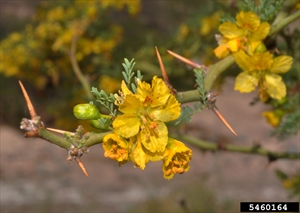- Widespread. Africa, Asia, North, South and Central America, Caribbean, Europe, Oceania. In Australia, FSM, Guam, New Caledonia.
- Invasive, large amounts of seed, tolerates range of soils, even those seasonally flooded. Found near creeks, rivers, bores and dams in semi-arid regions, but also grasslands, open woodlands, rangelands, pastures, waste areas, disturbed sites and roadside. Prevents cattle accessing water.
- Grows mostly 2-6 m, smooth, single or multi-stems that zigzag. Young stems with spines below each leaf. Leaves, up to 30 cm long, flat, green, long leaf stalks, with many, small, oblong leaflets. Flowers, up to 20 mm across with four yellow petals, and one erect orange or orange-spotted petal. Seed pods, long, straight with 1-4 seeds, occasionally more.
- Spread: suckers; seed by birds, cattle, water, vehicles.
- Biosecurity: high risk of introduction. In Australia, 'restricted invasive plant': do not release into environment, give away or sell.
- Biocontrol: two seed beetles, a leaf bug, a leaf-feeding looper have some potential.
- Cultural control: hand weeding, mechanical (use of chains, bulldozers); fire; restrict movement of sand and soil.
- Chemical control: choice of foliar, cut-basal-bark, soil or trunk treatments, depending on proximity to water, and size. In Australia: triclopyr + picloram; triclopyr + picloram + aminopyralid; picloram + aminopyralid. In Fiji, glyphosate.









